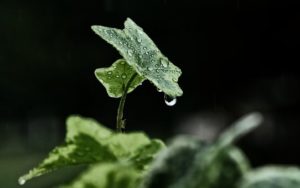
Do plants actually sweat?
How many times has someone pulled you into their office, pointing to their Ficus, saying, “ My plant is covered with bugs!! What are they and what are you going to do about them?”
No matter how many times this happens, it can always give you a little start. Your mind screams, “Oh No. How could I have missed seeing them? What’s it got? … Mites? …Oh please, not scale! Where is it? What could she mean? … It was fine last week.”
By the time you move in to take a closer look at what she is shrieking about I realize by her description that what she is referring to is the tree’s sweat gland deposit. It is that little drip of whitish hardened sap that is frequently at the base of the leaf of a Ficus. You can now calmly explain that although these drops can indeed resemble bugs they are simply sap deposits. The uniform little dots look and feel like little crystals of sugar.
Other Sweaty Plants
Ficus aren’t the only plants to produce that drip of sweat at the leaf base. Grape ivies and their other Cissus relatives are notorious for these little white crystals. Fatsia japonica and also tend to produce a sap deposit. Dracaena marginata will also exude sap in high light conditions. (This is not to be mistaken for drips caused by mite populations.)
Sweat gland drips are always at regular intervals and are deposited at the stomata opening. Learn to recognize them and know the difference from insect damage.
Magnifying glasses?
A hand held magnifying glass can be a helpful tool to carry with you. The 10x lens that attaches to your key chain will insure it is always handy. Some of us now prefer to carry “drug store brand reading glasses” to improve the up close picture. Whichever route you choose be sure to get in close and examine the suspected bug (or sap drip). Take a good look at the critter and the magnified damage it causes.
By carefully examining these small items you will eventually be able to recognize them from across the room — well at least some of the time.
